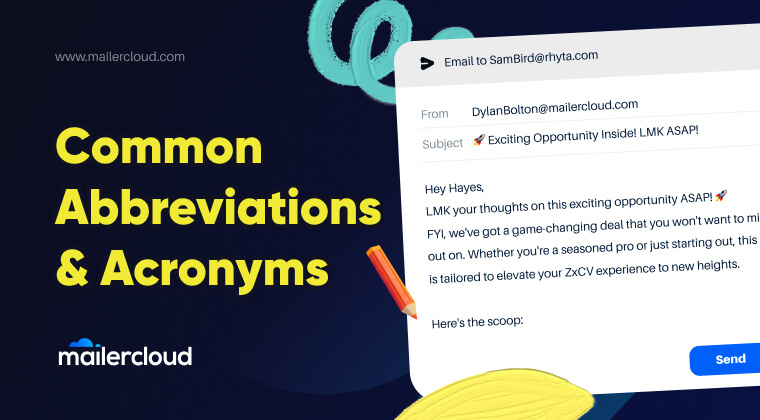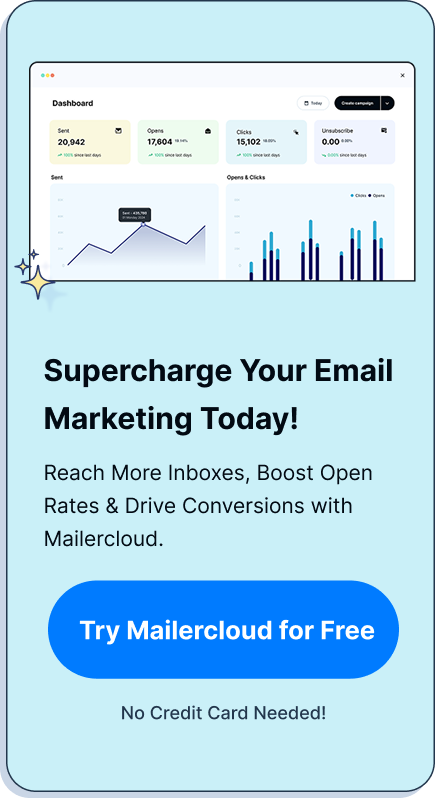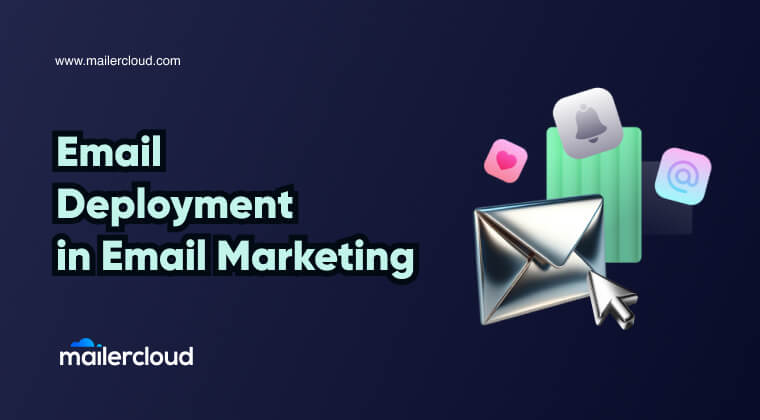Email abbreviations and acronyms are like secret codes that can save you time and make your communication more efficient. Whether you’re chatting with friends, sending emails to colleagues, or even writing a quick message to your boss, knowing these shortcuts can help you get your point across effortlessly.
Table of Contents
What are email acronyms and abbreviations?
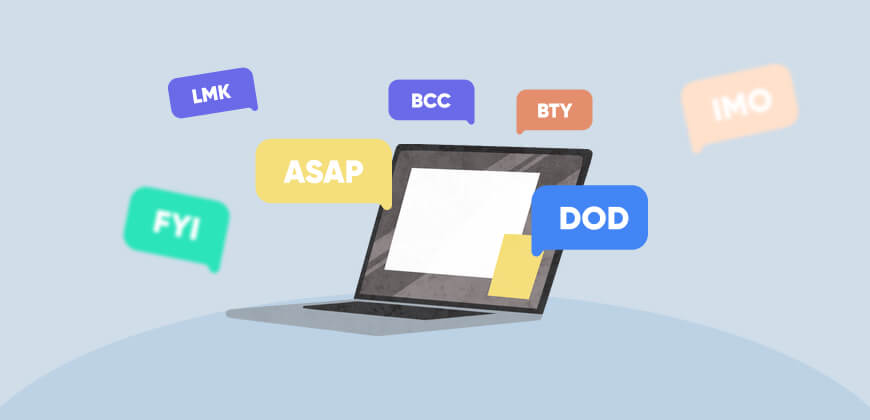
Abbreviations are shortened forms of words or phrases used to convey information concisely in email communication. Acronyms are words formed from the initial letters or parts of a longer phrase. In this blog we have provided you with a list of common acronyms and their usage in emails. In a professional environment, it’s important to use these shortcuts appropriately.
List of Email Acronyms and Abbreviations used in Business Sectors
BCC:
BCC stands for “Blind Carbon Copy” and is used to send a copy of an email to someone without the other recipients’ knowledge.
CC:
CC stands for “Carbon Copy” and is used to send a copy of an email to someone other than the main recipient(s).
OOO:
OOO is short for “Out of Office” and is used in email to indicate that the sender is currently unavailable.
EOM:
EOM stands for “End of Message” and is used when the entire message is contained in the subject line, and there is no need for an email body.
TL; DR:
TL; DR is used to mean “Too Long; Didn’t Read”, to provide a concise summary or highlight important points in an email so that the recipients do not have to read the entire email.
NNTR:
NNTR refers to “No need to respond” and is used to inform the recipient that they don’t need to reply to the email, which reduces email clutter from replies that are unnecessary.
NWR:
NWR is short for “Not work-related” and is used in business emails to indicate that the content is not business related and the recipient can ignore it if desired.
Subject Line Abbreviations
RE:
RE is short for “Regarding” or “In regard to” and is commonly used in the beginning of the subject to indicate the email subject.
FWD:
FWD refers to “Forward” and is used in the subject when forwarding an email to someone else.
EOD:
EOD stands for “End of Day”. It is used to specify a deadline or time frame for a task or response.
ASAP:
ASAP is the acronym for “As Soon As Possible” and is used to signify urgency or request prompt action.
NT or N/T:
NT or N/T stands for “No text” and is typically used when the email content is contained in the subject line and the email body remains empty and indicates that the recipient need not open the email.
SFW:
SFW is used to mean “Safe for work”. It indicates to tell the recipient that an email is completely fine to view at work.
PFA:
PFA stands for “Please find the attachment” and is typically used in an email either in the subject line or within the body to inform the presence of a set of documents attached along with the email.
Email Body Abbreviations
BTW:
BTW refers to the term “By the Way” and is used to introduce additional information or a side note that you want to let people know.
FYI:
FYI is short for “For Your Information” and is frequently used to share some helpful information without expecting a specific action or response.
LET:
LET is the abbreviation for “Leaving Early Today”. This abbreviation is used commonly in group emails to inform others that you are leaving early.
NWS:
NWS is short for “Not work-safe”. Used in email subject line to urge the viewer to avoid the email in a professional setting. The email may be sexually explicit or profane, making it inappropriate to view.
Popular Email Acronyms
BRB:
BRB is short for “Be Right Back”. It is used in an informal email and the business world to inform the recipient that the sender will return shortly.
IMO/IMHO:
IMO/IMHO is used to refer to phrases like “In My Opinion” and “In My Humble Opinion,” respectively, to express personal opinions.
PS:
PS stands for “Post scriptum” and is given in emails at the end to showcase an afterthought.
FYR:
FYR is the abbreviation of “For your reference” and used when sending a follow-up information about something the recipients already know.
Business Email Etiquette
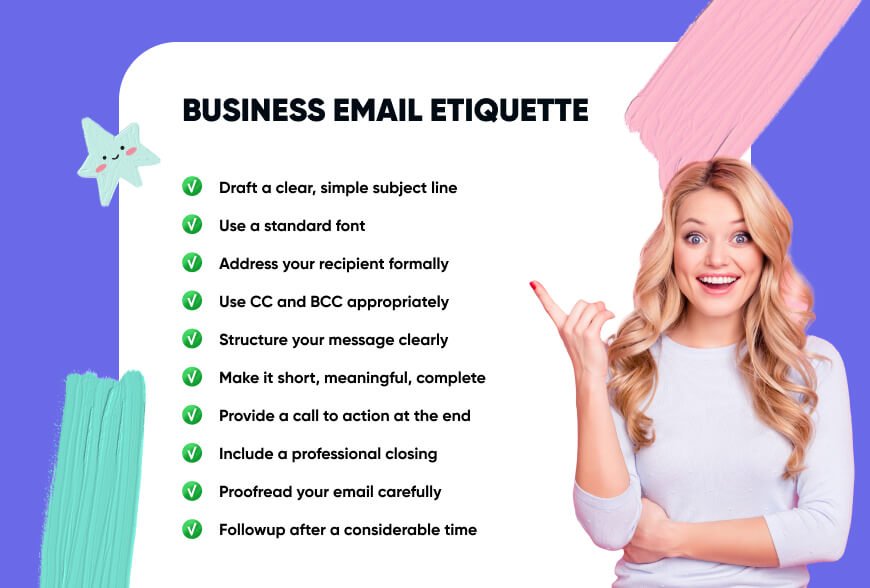
Business email etiquette is an essential skill that professionals should master. When communicating through email, it is important to follow certain guidelines to ensure effective and professional communication.
Firstly, it is crucial to use a clear and concise subject line that accurately conveys the purpose of the email. This helps recipients prioritize the subject of the email and respond to emails more efficiently. Additionally, it is important to use a professional tone and language in all email correspondence. This means avoiding slang or informal language and using proper grammar and punctuation.
It is also essential to be mindful of the recipient’s time by keeping emails concise and to the point. However, it is equally important to provide enough information to convey your message effectively. Another key aspect of email etiquette is responding promptly to emails. This shows respect as it saves the recipient time and helps maintain a productive working relationship.
Finally, it is crucial to proofread and edit your emails and use appropriate acronyms in your email program before sending them, to ensure that they are error-free and professional in nature. By following these guidelines, professionals can ensure that their business emails are effective, professional, and reflect positively on their personal brand.
Wrapping up:
Understanding email shortcuts is essential for effective communication in today’s fast-paced digital world. By incorporating these abbreviations into your email writing, you can enhance your efficiency, save time, and streamline your communication process.
Now that you’re equipped with the common email lingo, you’ll be able to communicate more efficiently and effectively in your everyday email exchanges! Please note that explicit or profane language should never be used in professional email communication.
Lina is a content writer with a passion for reading, writing, and cooking. She aims to explore the world of words and flavors. With a deep love for literature and a knack for creating mouthwatering recipes, she strive to engage and inspire others through her work.





























